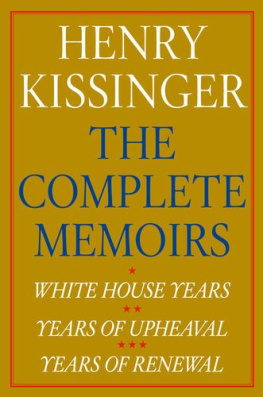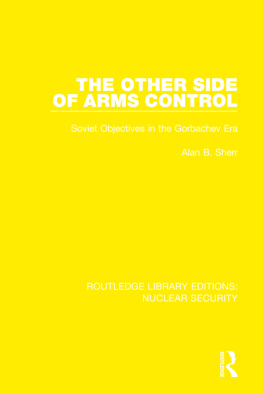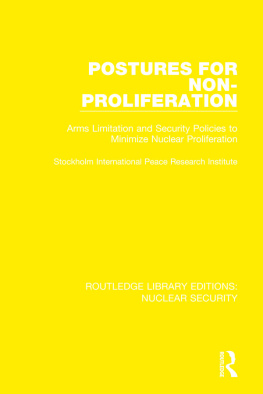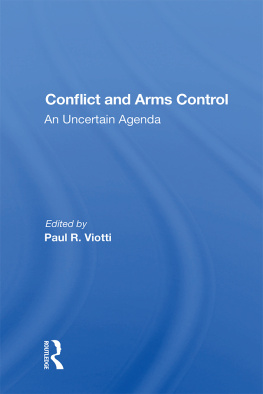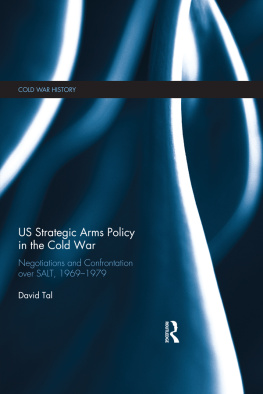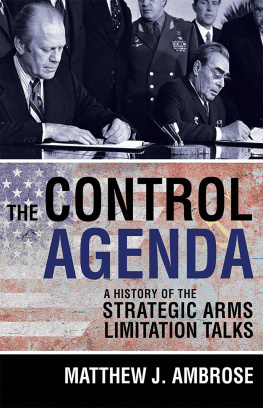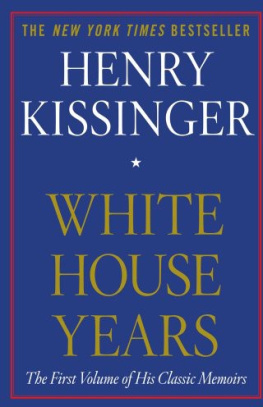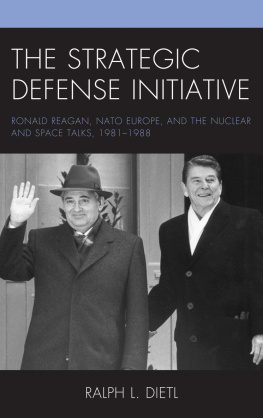COMPETITIVE ARMS CONTROL
Competitive Arms Control
NIXON, KISSINGER, AND SALT, 19691972
JOHN D. MAURER
Yale UNIVERSITY PRESS
NEW HAVEN AND LONDON
Published with assistance from the foundation established in memory of Amasa Stone Mather of the Class of 1907, Yale College.
Copyright 2022 by John D. Maurer.
All rights reserved.
This book may not be reproduced, in whole or in part, including illustrations, in any form (beyond that copying permitted by Sections 107 and 108 of the U.S. Copyright Law and except by reviewers for the public press), without written permission from the publishers.
Yale University Press books may be purchased in quantity for educational, business, or promotional use. For information, please email (U.K. office).
Set in Scala and Scala Sans types by Newgen North America.
Printed in the United States of America.
Library of Congress Control Number: 2021949868 ISBN 978-0-300-24755-8 (hardcover : alk. paper)
A catalogue record for this book is available from the British Library.
This paper meets the requirements of ANSI/NISO Z39.48-1992 (Permanence of Paper).
10 9 8 7 6 5 4 3 2 1
To my father, the Elder
CONTENTS
ACKNOWLEDGMENTS
This book began life as a dissertation on American arms control policy during the Cold War. Its earliest iterations were refined with the assistance of my dissertation committee, David Painter, Keir Lieber, and Kathryn Olesko. Additional thanks go to my many teachers and colleagues at Georgetown: Gregory Brew, Daniel Byman, Michael David-Fox, Anthony Eames, Chad Frazier, Toshihiro Higuchi, Oliver Horn, Robert Lieber, Robynne Mellor, Aviel Roshwald, and Adam Rothman. Nicholas Myers and Eric Sand provided feedback on parts of the project. Carolina Madinaveitia provided invaluable help in navigating the procedural aspects of producing a dissertation at Georgetown. Carla Braswell, William Burr, Richard Moss, and James Neel offered advice on locating the relevant sources and archives. Funding for the dissertation was provided by the Cosmos Club Foundation of Washington, D.C., as well as the Gerald R. Ford Foundation.
Transforming the dissertation manuscript into a book was supported by Yale Universitys Johnson Center for the Study of American Diplomacy and International Security Studies (ISS). Thanks go to Fritz Bartel, Ian Johnson, Paul Kennedy, Nuno Monteiro, Evan Wilson, and Ted Wittenstein. Michael Brenes provided advice on further archival resources, including the Henry Kissinger Papers at the Yale Library, while Larisa Satara provided advice on Yale more generally. My work also benefited from the feedback of Jean-Franois Blanger, Tyler Bowen, Tim Choi, Susan Colbourn, Michael Franczak, Mathias Frendem, Mayumi Fukushima, Eliza Gheorghe, Michael Goldfien, Mariya Grinberg, Michael De Groot, Louis Halewood, Stephen Herzog, Michael Joseph, Jack Loveridge, David Minchin, Veysel imek, Peter Slezkine, Jan Stckmann, Emily Whalen, Claire Yorke, and Remco Zwetsloot. Paul Bracken provided a patient sounding board for my ideas on policy implications, while Robert Pfaltzgraff, Jr., offered insights into past arms control debates. Michelle Brown advised on additional research in the National Archives.
In completing the manuscript during the COVID pandemic, I relied on the assistance of many friends and colleagues. The first full draft of the book was written during an additional fellowship at the American Enterprise Institute in Washington, D.C. Thanks go to Nicholas Eberstadt, Danielle Pletka, Kori Schake, and Gary Schmitt for supporting my work. Matthew Ambrose, Hal Brands, Frank Rose, William Schlickenmaier, Henry Sokolski, and Pranay Vaddi all provided useful discussion about both the history and future of American nuclear weapons policy. Evan Abramsky heroically read the first draft from beginning to end, providing useful feedback. Final edits to the manuscript took place while I was teaching at the School of Advanced Air and Space Studies (SAASS) at Air University, thanks to Col. Sean Cochran, Col. Jeffrey Donnithorne, and Derrick Frazier. Special thanks also go to Jaya Chatterjee, Kristy Leonard, and Eva Skewes at Yale University Press for helping guide the book to its conclusion, as well as to the two anonymous readers for their helpful comments.
Finally, this book was only possible with the love and support of my family. My parents, John and Maureen Maurer; my siblings, Margaret, James, and Clara Maurer; and my in-laws, David, Vivian, and Greg Shaull, provided endless encouragement for my work. My wife, Rebecca Maurer, endured with patience the many ups and downs of graduate school and postdoctoral life, and was always ready with good counsel. My daughter, Casey Marie Maurer, was a late addition to the team. She provided important perspective on the challenges of completing the book, along with much joy.
ACRONYMS
| ABM | Anti-Ballistic Missile |
| ACDA | Arms Control and Disarmament Agency |
| ARVN | Army of the Republic of Vietnam |
| CIA | Central Intelligence Agency |
| CJCS | Chairman, Joint Chiefs of Staff |
| CMPDP | Committee to Maintain a Prudent Defense Policy |
| DCI | Director of Central Intelligence |
| DPRC | Defense Program Review Committee |
| FBS | Forward-Based Systems |
| FOFA | Follow-on Forces Attack |
| FRG | Federal Republic of Germany |
| ICBM | Intercontinental Ballistic Missile |
| INF | Intermediate-Range Nuclear Forces |
| JCPOA | Joint Comprehensive Plan of Action |
| JCS | Joint Chiefs of Staff |
| MARC | Modern ABM Radar Complex |
| MIRV | Multiple Independently Targeted Reentry Vehicle |
| MRV | Multiple Reentry Vehicle |
| NATO | North Atlantic Treaty Organization |
| NCA | National Command Authority |
| NIE | National Intelligence Estimate |
| NSC | National Security Council |
| NSDM | National Security Decision Memorandum |
| NSSM | National Security Study Memorandum |
| OLPAR | Other Large Phased Array Radar |
| OMB | Office of Management and Budget |
| PSAC | Presidents Science Advisory Committee |
| SAIS | School of Advanced International Studies |
| SALT | Strategic Arms Limitation Talks |
| SAM | Surface-to-Air Missile |
| SDI | Strategic Defense Initiative |
| SLBM | Submarine-Launched Ballistic Missile |
| SORT | Strategic Offensive Reductions Treaty |
| SSBN | Nuclear-Powered Ballistic Missile Submarine(s) |
| START | Strategic Arms Reduction Talks |
| SWWA | Stop Where We Are |
| ULMS | Undersea Long-Range Missile System |
| VPK | Voyenno-Promyshlennaya Kommisiya (Military-Industrial Commission) |
Introduction
PRESIDENT RICHARD NIXON WAS in a celebratory mood as he stepped to the podium on October 3, 1972. He had a good deal to celebrateafter nearly four years of difficult negotiations, the United States and the Soviet Union had finally ratified the first round of agreements from the Strategic Arms Limitation Talks (SALT). To the assembled notables, Nixon reflected:
These agreements mean a first step in reducing the danger of war in the world and increasing the chances of peace... the signing of these documents today... raise the hopes of all the people of the world for a dream of mankind from the beginning of civilization, a world of peace, a world in which peoples with different governments and different philosophies could live in peace together.


